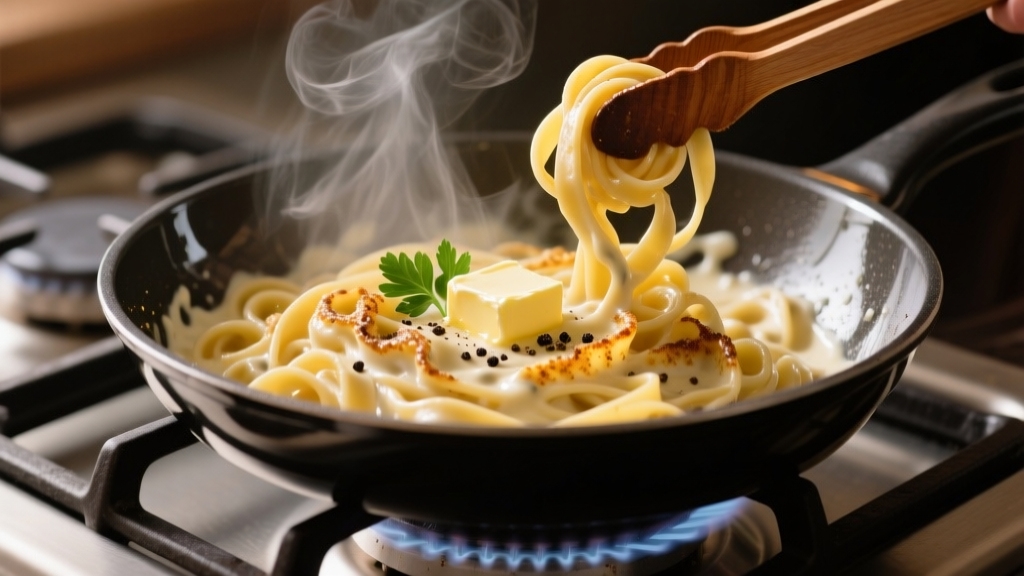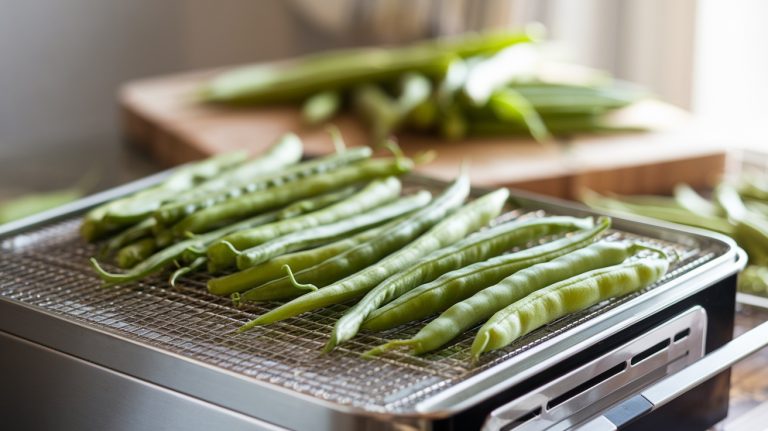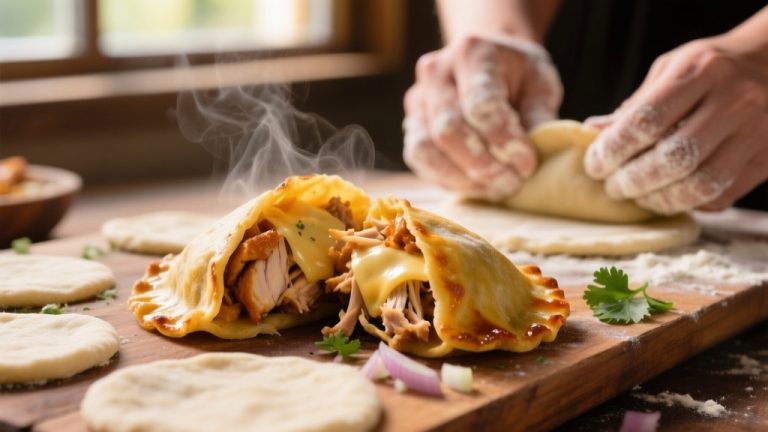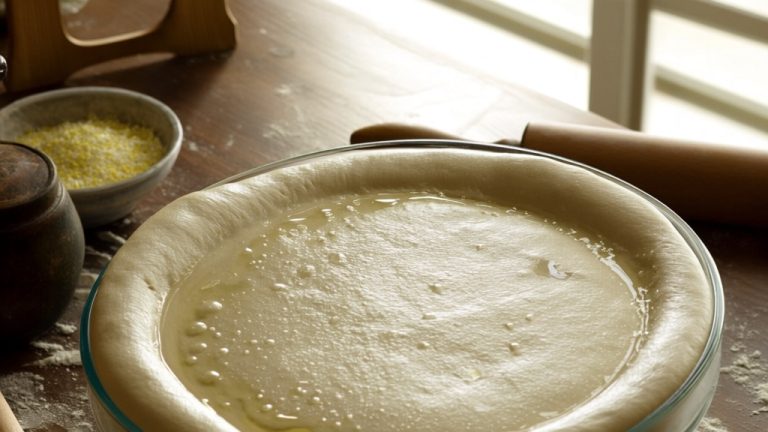How to Reheat Alfredo Pasta? Easy Methods for Creamy Results
To reheat Alfredo pasta well, heat it gently on low or medium heat while stirring frequently to keep the sauce smooth and creamy. Add a splash of milk or cream to restore moisture and prevent separation.
You can also warm it in the oven at 350°F covered with foil for 15–30 minutes or microwave on 50% power in short intervals, stirring between each.
Keeping these steps in mind preserves texture and flavor. Explore how to perfect your reheating technique efficiently.
Key Takeaways
- Reheat Alfredo pasta in the oven at 350°F with added milk, covered with foil, stirring halfway for 15–30 minutes for even heating.
- Microwave on 50% power in 30-second intervals, stirring and adding a splash of milk or cream to maintain sauce creaminess.
- Gently reheat on the stovetop over low heat, stirring frequently and adding dairy gradually to prevent sauce separation.
- Cover the pasta while reheating to trap moisture and prevent drying out, whether using oven or microwave methods.
- Reheat smaller portions for faster, more even warming and better sauce texture, stirring regularly to keep the sauce emulsified.
Best Methods for Reheating Alfredo Pasta
When reheating Alfredo pasta, choosing the right method guarantees the sauce stays creamy and the pasta retains its texture.
You can use the oven by preheating it to 350°F (180°C). Place the pasta in an oven-safe dish with a splash of milk or water, and cover it with foil. This method is similar to reheating other sauces that have a higher water content, which benefits from added moisture during heating.
Heat for about 10 minutes, stirring and adding liquid as needed until warmed through. Because Alfredo sauce is an emulsion of fat, gentle heating helps maintain its creamy consistency.
Alternatively, use the microwave on 50% power, reheating in 30-second intervals and stirring between to prevent sauce separation.
For the gentlest approach, employ a double boiler: simmer water and place the pasta in a heatproof bowl above it, stirring regularly.
Adding moisture during reheating is essential to keep the sauce smooth and prevent dryness or thickening.
Tips for Stovetop Reheating
Stovetop reheating offers greater control over heat and consistency, making it an excellent choice to preserve the creamy texture of Alfredo pasta.
Begin by using medium-low to low heat in a heavy-bottomed or nonstick pan to prevent sauce separation and burning. Using a pan with adjustable heat control ensures even warming and prevents hot spots.
Stovetop reheating on low heat preserves Alfredo pasta’s creamy texture while preventing sauce separation and burning.
Gradually add a splash of milk or cream as the sauce warms to maintain its smoothness, stirring frequently with a wooden spoon or whisk to ensure emulsification. Avoid boiling; instead, allow a gentle simmer and reduce heat if the sauce starts to separate or stick.
Breaking the heat into controlled increments is crucial because fat separates from the cream when overheated. Break up any clumps gently to protect the noodles. Reheat slowly and monitor temperature carefully, adding liquids incrementally rather than all at once.
Using the Oven to Warm Alfredo Pasta
Because Alfredo pasta can dry out easily, using the oven to reheat it requires careful temperature control and moisture management.
Preheat your oven to 350°F (180°C) and place the pasta in an oven-safe dish. Add a splash of milk, cream, or water to maintain sauce creaminess, then cover tightly with foil to trap steam. Covering the dish also helps to prevent drying out during reheating. For best results, ensure the dish is placed on a level, stable surface to promote even heating.
Heat for 15–30 minutes, stirring gently halfway through to redistribute heat and prevent clumping. For larger portions, extend reheating to 30–45 minutes, adding liquid if the sauce thickens.
Ensure the internal temperature reaches at least 135°F for safety, especially with meat-based Alfredo.
Microwave Reheating Techniques
When reheating Alfredo pasta in the microwave, set the power to low or medium to prevent the sauce from separating. Using lower power settings also allows for more controlled heating, which is crucial for maintaining the sauce’s consistency and flavor.
Heat in short bursts of 30 seconds, stirring frequently to ensure even warmth and preserve texture. To keep the sauce creamy, add a splash of milk or cream before microwaving. This also helps prevent the pasta from drying out.
Cover the dish with a damp paper towel or plastic wrap to retain moisture and heat evenly, which further aids in maintaining the sauce’s creaminess and smoothness. Proper kitchen tool maintenance like regular cleaning and care can enhance reheating results and overall food quality.
Power Settings and Timing
Although reheating Alfredo pasta in the microwave may seem straightforward, using the right power settings and timing is essential to maintain its creamy texture and prevent sauce separation.
Set your microwave to 50% power (medium) or use the reheat setting if available. Avoid high power, which can cause overheating and sauce splitting, similar to how uneven heat distribution can affect cooking quality in other dishes.
Heat in 30-second to 1-minute intervals, stirring gently between each to distribute heat evenly and sustain emulsification.
To prevent the sauce from breaking apart, it is also helpful to add a splash of milk or cream before microwaving to restore its creaminess and moisture.
Total reheating typically takes 2 to 4 minutes, depending on quantity and wattage. After each interval, check the pasta’s firmness and sauce consistency to avoid dryness or rubberiness.
Moisture Retention Tips
Mastering power settings and timing lays the foundation for reheating Alfredo pasta without compromising texture, but maintaining moisture during the process is equally important to preserve its creamy consistency.
Cover your pasta with a damp paper towel or a microwave-safe lid with vent holes to trap steam and prevent drying. Using a medium power setting helps ensure gentle reheating that protects the sauce’s texture.
Drizzle 1-2 tablespoons of water or extra sauce before reheating to enhance moisture retention without diluting flavor.
Use a round or oval glass container for even heat distribution, and arrange pasta loosely to allow steam circulation. Stir periodically during reheating to promote even heat distribution and prevent hot spots.
Heat at medium power in 1-2 minute intervals, stirring gently between cycles to redistribute moisture evenly.
Avoid reheating uncovered or at full power, as this causes rapid moisture loss and toughens the sauce and noodles.
Maintaining Sauce Creaminess and Stability
To maintain your Alfredo sauce’s creaminess, apply gentle heat and avoid high temperatures that can cause separation. Stir continuously to keep the sauce emulsified and prevent scorching.
Adding small amounts of dairy like cream or milk during reheating helps restore moisture and smooth texture.
Using a heat-resistant silicone spatula can help gently stir and scrape the sauce without damaging the container or affecting the sauce’s consistency.
Gentle Heat Application
When reheating Alfredo pasta, applying gentle heat is essential to preserve the sauce’s creamy texture and prevent separation. Whether you use the oven, stovetop, or microwave, keep the temperature low and add small amounts of milk or water to maintain moisture. Cover your dish to trap steam and avoid drying.
Heating in intervals with gentle stirring helps redistribute heat evenly, preventing curdling or oily separation. Here’s a quick guide:
| Method | Temperature/Power | Key Tips |
|---|---|---|
| Oven | 350°F (180°C) | Cover with foil; add liquid |
| Stovetop | Medium-low heat | Use non-stick pan; add cream |
| Microwave | 50% power | Heat 30-second increments; cover |
Choosing the right tools, such as non-stick cookware, can also improve heat distribution and help maintain sauce quality during reheating. Use gentle heat consistently to keep your Alfredo sauce smooth and stable.
Continuous Stirring Importance
Although gentle heat is essential, continuous stirring plays an equally important role in maintaining the creamy texture and stability of Alfredo sauce during reheating. By stirring constantly, you guarantee even heat distribution, preventing localized overheating that causes fat to separate and the sauce to break.
This agitation keeps fat molecules suspended uniformly, preserving the smooth emulsion and preventing oily patches. Stirring also controls temperature, avoiding curdling by dispersing heat and preventing hot spots where dairy proteins denature.
It helps maintain a consistent, silky texture by gently breaking up pasta clumps and integrating any added liquids. Continuous stirring allows you to monitor and adjust the sauce’s consistency in real time, ensuring the Alfredo sauce remains rich, homogeneous, and flavorful throughout the reheating process.
Dairy Addition Benefits
Since Alfredo sauce tends to lose its creamy texture during reheating, adding dairy such as milk or cream can effectively restore its smoothness and richness. Incorporating small amounts of whole milk or heavy cream helps reincorporate separated fats, preventing dryness or clumping.
The dairy proteins rebind fats and liquids, stabilizing the sauce’s emulsion and maintaining a smooth mouthfeel without thinning it excessively. For best results, add dairy gradually over low to medium heat while stirring continuously to avoid curdling and phase separation. Warming dairy separately before mixing prevents temperature shocks.
Using a stovetop method with medium-low heat and constant stirring is ideal to gently reheat Alfredo sauce without causing it to separate. Additionally, using cookware with even heat distribution can further prevent hot spots that may cause sauce breakdown.
Keep in mind that added dairy increases calories and saturated fat, so measure carefully. Use fresh, high-quality dairy and avoid multiple reheating cycles to preserve the sauce’s flavor, texture, and safety.
Portion Size and Reheating Efficiency
Because portion size directly influences reheating time and temperature, managing it carefully guarantees your Alfredo pasta heats evenly without drying out or overcooking. Smaller portions reheat faster and more uniformly, minimizing nutrient degradation and bacterial risks.
When reheating larger servings, divide them into smaller containers to improve heat penetration and reduce reheating duration. Thinner layers also promote efficient warming whether using a microwave, oven, or stovetop.
For big portions, stirring mid-reheat ensures consistent temperature and texture. Additionally, controlling portion size reduces energy consumption and food waste by allowing you to reheat only what you’ll eat.
Keep servings moderate, around 70 to 283 grams, to balance reheating efficiency, nutrient retention, and food safety. The standard serving size of FARMHOUSE Fettuccine Alfredo pasta is 70 g, which provides a useful benchmark for portioning your reheats standard serving size.
This approach optimizes both the quality and enjoyment of your reheated Alfredo pasta.
Preventing Sauce Separation During Reheating
To prevent Alfredo sauce from separating during reheating, you’ll need to carefully control the temperature and moisture levels. Overheating cream-based sauces causes fat to separate, creating a greasy texture.
Use low or medium heat, whether on the stovetop or microwave, and heat incrementally, stirring frequently to distribute heat evenly. For best results, reheat on stovetop using a heavy-bottomed pan to ensure gentle, even heating that preserves the sauce’s texture.
Careful temperature control and gentle stirring prevent Alfredo sauce from separating and becoming greasy during reheating.
Adding a splash of water, pasta cooking water, or olive oil helps maintain the sauce’s smooth emulsion. Cover the container to trap steam and avoid drying out the sauce. If possible, reheat pasta and sauce separately to optimize temperature control and recombine gently afterward.
- Reheat on low to medium heat only
- Stir gently every 15–30 seconds during microwaving
- Add small amounts of water or olive oil to loosen sauce
- Cover the dish to retain moisture
- Reheat sauce and pasta separately when possible
Frequently Asked Questions
Can I Freeze Leftover Alfredo Pasta Before Reheating?
Yes, you can freeze leftover Alfredo pasta before reheating. For best results, freeze the pasta and sauce separately to maintain texture and flavor.
Cool both completely, toss the pasta with olive oil to prevent sticking, then store in airtight containers or freezer bags. Label with the date and use within 1-2 months.
When ready, thaw overnight in the fridge and reheat gently to preserve quality and safety.
How Long Can Alfredo Pasta Be Safely Stored Before Reheating?
Oh sure, keep that Alfredo pasta lounging in your fridge indefinitely, because who wouldn’t want a dairy-based science experiment growing mold?
Realistically, you’ve got 3 to 5 days to safely store your Alfredo pasta before reheating.
Make sure you refrigerate it within 2 hours after cooking, use airtight containers, and label the date.
Beyond five days, you’re risking spoilage and foodborne illness. Definitely not worth the gamble.
Heat to 165°F before eating.
What Are the Best Types of Pasta to Use With Alfredo Sauce?
You’ll want to choose pasta with wide, flat surfaces like fettuccine or pappardelle. They hold Alfredo sauce beautifully.
Textured shapes such as cavatappi or ridged penne trap the creamy sauce well, enhancing flavor. Avoid thin strands like spaghetti since they don’t cling as effectively.
Also, consider pasta that’s firm yet elastic to absorb sauce without falling apart. This balance guarantees every bite is rich and well-coated.
Can I Reheat Alfredo Pasta With Added Vegetables or Proteins?
Imagine you cooked chicken Alfredo with broccoli for dinner and want to reheat leftovers safely. Yes, you can reheat Alfredo pasta with veggies or proteins, but do it gently on the stovetop over low heat.
Stir often and add a splash of milk to keep the sauce creamy.
Make sure the internal temperature reaches at least 165°F to guarantee safety, especially for proteins. Avoid high heat to prevent sauce separation and uneven cooking.
Is It Safe to Reheat Alfredo Pasta Multiple Times?
You shouldn’t reheat Alfredo pasta multiple times because each cycle increases bacterial risk and reduces food quality.
Only reheat the portion you plan to eat immediately, ensuring it reaches 75°C throughout.
Cool leftovers quickly within two hours and store below 5°C.
Reheated pasta can suffer from sauce separation, texture changes, and potential toxin formation if reheated multiple times.
For safety and taste, limit reheating to once and handle leftovers with strict hygiene and proper storage.
Enjoy Alfredo Pasta Freshly Reheated Every Time
Reheating Alfredo pasta is like reviving a creamy masterpiece. Handle it with care to preserve its rich texture and delicate flavors.
By choosing the right method, whether stovetop, oven, or microwave, you’ll keep the sauce velvety and prevent separation. Remember, smaller portions heat more evenly, ensuring every bite tastes fresh.
With these techniques, you’ll transform leftovers into a dish that’s just as decadent as the first time you enjoyed it.







